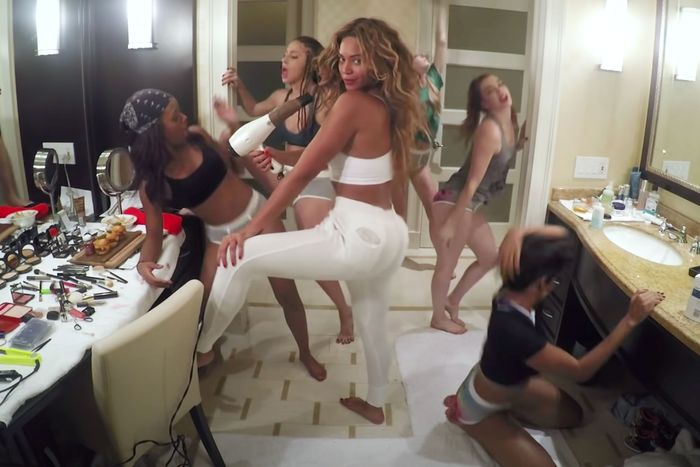
Every Beyoncé song is a dance song in the right circumstances. But the queen also has a rich history of explicitly making Dance Music — that is, songs that draw on the sort of music meant to get people moving in clubs. (To say nothing of her remarkably intense choreography, a staple of her performances since her work with Destiny’s Child.) Her new album, Renaissance, is reportedly a house-influenced record; the first single, “Break My Soul,” is evidence as much: a house-pop track built off a synth line recalling Robin S.’s instantly recognizable “Show Me Love.” Judging by the credits — among the names: Donna Summer, Nile Rodgers, Honey Dijon — Bey could have everything from disco to Miami bass to futurepop in store. But before we get to groove to those songs, let’s take a journey back through her catalogue of dance.
“Crazy in Love” (2003)
Dangerously in Love, first and foremost, attempts to establish Beyoncé as a star in R&B, so it’s short on the genre-bending that would later become a hallmark of her style. But we should recognize Queen Bey’s debut solo single, “Crazy in Love,” which became the first song to top Billboard’s then-new Hot Dance Airplay chart, where it stayed for seven weeks. (Beyoncé has gone on to top the chart 21 more times.) The track comes out the gate as a crowd-pleaser, with a huge horn sample from the Chi-Lites’s “Are You My Woman (Tell Me So)” and hooky “uh-oh” refrain. But it’s the throwback funky percussion and four-on-the-floor chorus that makes “Crazy in Love” a dance favorite.
“Naughty Girl” (2003)
Beyoncé’s sample of Donna Summer on “Summer Renaissance” won’t just call back to disco’s greatest — it’ll also call back to a time Beyoncé interpolated the “Last Dance” singer. Though “Naughty Girl” isn’t quite a dance track, it did show Beyoncé’s deftness with old musical references, as the song is built around the hook for Summer’s sensual anthem “Love to Love You Baby.” By singing the line herself — in an equally airy upper register to match the legendary performer — Beyoncé brings the track to the present.
“Baby Boy” (2003)
Beyoncé has been engaging in cross-cultural collaborations since the start of her career, and some of her best dance songs have been rooted in non-American styles. The hypercatchy “Baby Boy” is a perfect example: Beyoncé slips right into the dancehall–meets–R&B track, trading lines with Sean Paul, who was in the process of establishing himself as one of Jamaica’s most influential crossovers. And of course, that springy beat makes it impossible for listeners to stay still.
“Green Light” (2006)
The humble cowbell: the anchor of so many great dance songs, from Madonna’s “Holiday” to Crystal Waters’s house-pop masterpiece “100% Pure Love.” That’s what helps “Green Light” make the cut here. The song reteams Beyoncé with the Neptunes, who previously produced her Austin Powers song “Work It Out”; Pharrell Williams has also had a hand in another of her best dance songs, in “Blow.”
“Get Me Bodied (Extended Mix)” (2006)
Beyoncé’s foray into music for dancing really starts with “Get Me Bodied.” It’s the first song that she released an extended mix of, a practice that dates back to 1970s disco. It also marks the beginning of Beyoncé’s long fascination with bounce music, the high-energy New Orleans style that she’d work with more directly later in her career. And hell, Bey even tells you how to dance to the song in the break and the music video. What more do you need?
“Beautiful Liar” (2006)
Beyoncé teamed up with another dancing queen, Shakira, for this track off the deluxe B’Day. It blends a number of the Latin and Arabic dance styles in Shakira’s wheelhouse, including mariachi, flamenco, and traditional Middle Eastern music (often used for belly dancing, as referenced in the video). It was all pretty far outside Beyoncé’s comfort zone at the time, but she still runs the show.
“Single Ladies (Put a Ring on It)” (2008)
It’s the song that created an instantly recognizable dance craze. And if that’s not enough — well, stylistically, “Single Ladies” is also a dance song through and through, returning to Beyoncé’s jittery bounce influence while also incorporating some of the electropop flair that defined the second side of I Am … Sasha Fierce.
“Radio” (2008)
But if we’re talking about electropop on Sasha Fierce, we really need to be talking about this song. “Radio” has a huge Eurodance-style drop that would end up all over pop music in the next few years, and it consequently became a hit in the Netherlands. Forget that title — this is one for the club.
“Telephone” (2009)
As for the Beyoncé song all over American clubs at the turn of the decade? That’d be “Telephone,” her collaboration with an up-and-coming dance-pop artist named Lady Gaga. The song brought Bey to the subcultural world of the New York underground, with its dirty synths and a speaker-breaking chorus. Over a decade later, it’s one of her most enduring dance hits — and that rap verse can still unite a floor like nothing else.
“Party” (2011)
Like how some of the best funk songs are about funk and the best rock songs are about rocking, many of the best party songs are about, well … you know. Beyoncé’s contribution makes good on its titular promise as a low-key dance groover, all based off a sample of “La Di Da Di,” by Doug E. Fresh and Slick Rick (then known as MC Ricky D). Like a good party, none of it sounds like work, from André 3000’s effortlessly in-the-pocket verse to Beyoncé’s bursting vocals.
“Schoolin’ Life” (2011)
Before what’s likely to come on Renaissance, “Schoolin’ Life” was Beyoncé’s best and truest disco song. The 4 deluxe cut packs in the genre signifiers: laser-sharp synths, horn fills, skittering drums, and a massive diva vocal from the queen herself. It’s a song about how Beyoncé just does it better — and she proves it right on this track.
“Haunted” (2013)
Sure, it might be difficult to dance to “Haunted.” But the song is rooted firmly in dance culture, pulling from some more left-field club styles like trance and the work of Aphex Twin — particularly on the dark first half, titled “Ghost.” At the time, Beyoncé’s spoken-word delivery reminded critics of Madonna’s “Justify My Love,” a song that marked another left turn from a dance great.
“Blow” (2013)
That nimble, slinky guitar riff on “Blow” is straight from Prince and Nile Rodgers’s playbook — that is, it’s meant to affect you on a bodily level. It works fantastically on this song, an ’80s throwback all the way down to the accompanying roller-rink visual. (Once again, thank Pharrell, an expert in retro-tinged pop.)
“7/11” (2014)
If “7/11” came out today, it’d surely have a TikTok dance to go with it. Can’t you see the hand-waving and ass-smacking already? One of the loosest songs from a notorious perfectionist, “7/11” had a music video resembling a viral clip. With its ever-shifting trap percussion and Beyoncé’s edited vocals, the track splits the difference between the high-energy SoundCloud rap and pixelated hyperpop to come in the next decade of internet-born music.
“Formation” (2016)
“Formation” ups Beyoncé’s past flirtations with bounce as a full-out tribute to New Orleans culture and music, in the video as well as the track itself. (The sample from NOLA’s own Big Freedia preceded her feature on “Break My Soul.”) The single, one of Beyoncé’s most lauded, is way more than just a dance song — it’s a stylistic melting pot that pulls from trap, includes some hard bars from Queen Bey, and features a full damn marching band.
“Mi Gente (Remix)” (2017)
Beyoncé’s skill and history drawing from other cultures makes her uniquely positioned to adapt to trends — like when she hopped on the remix of J. Balvin and Willy William’s “Mi Gente” as reggaeton was growing in the U.S. The song is actually more accurately described as moombahton, like reggaeton-inflected house, bridged together by clangy percussion and hooky synth lines. It already worked as a dance song, but Beyoncé’s 110 percent contribution made it a song for anyone to dance to, as she so skillfully can.
“Before I Let Go” (2019)
For a dance song to work, it needs to be accepted as a dance song — that is, people need to actually dance to it when they hear it. That response can even transform a song not explicitly created for dancing, like Maze’s “Before I Let Go.” Beyoncé’s spin on the Black anthem was the cherry on top of Homecoming, full of love for Historically Black Colleges and Black culture at large. With a trap-pop beat from Tay Keith and a smooth-as-hell dance break, her take is familiar enough to please a crowd, but innovative enough to rank among her best work.
“Mood 4 Eva” (2019)
Just as Afrobeat began to cross over in the west, Beyoncé made an album-length tribute to African pop on The Gift, her companion to The Lion King — and later, soundtrack to Black Is King, a fabulous showcase of dance on its own. “Mood 4 Eva” is a joyous highlight, bridging Afrobeat with trap for another song about making the most of a night. Childish Gambino actually puts the song’s mission best: “Ancestors in my step / Now I move better.”


